Part 68: Midwest: April 19, 1945

Axis Turn 22: April 19, 1945
Fair (Dry)
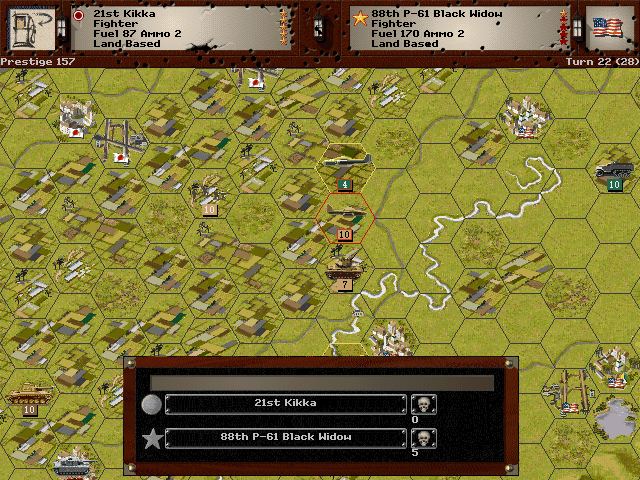
We strike back and win the air duel.

The Americans have all but abandoned these cities in Michigan.

We rush to contain the Iowa Insurrection.
Current VP level is a Decisive win, but we actually have to hold out until the last turn, unless we try to capture all objectives including the German ones.
Allied Turn 22: April 19, 1945
Fair (Dry)

American forces retake more cities in western Iowa.

The American planes retreat, but a few new forces appear in Ohio.
German Turn 22: April 19, 1945
Fair (Dry)
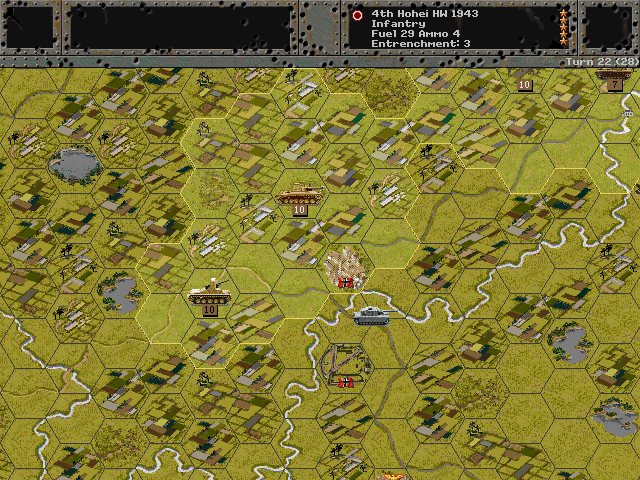
The Germans decide to pull out of Indiana, and cross back over the river.
Axis Turn 23: April 19, 1945
Fair (Dry)

The Americans don't seem to have much good equipment in Iowa. We bring our reserve tanks to bear, and they start blasting away.

Some of our older planes were held back to keep them out of range of the American fighters, and they are the first to strike back as well.
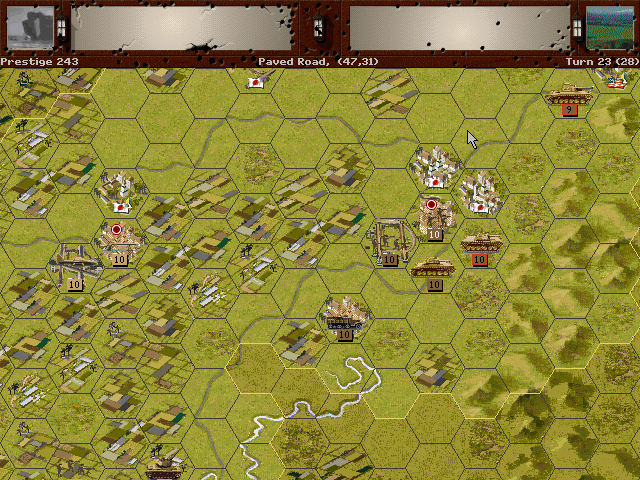
Dayton is secured, and we start to scout the rest of this territory.
Allied Turn 23: April 19, 1945
Fair (Dry)
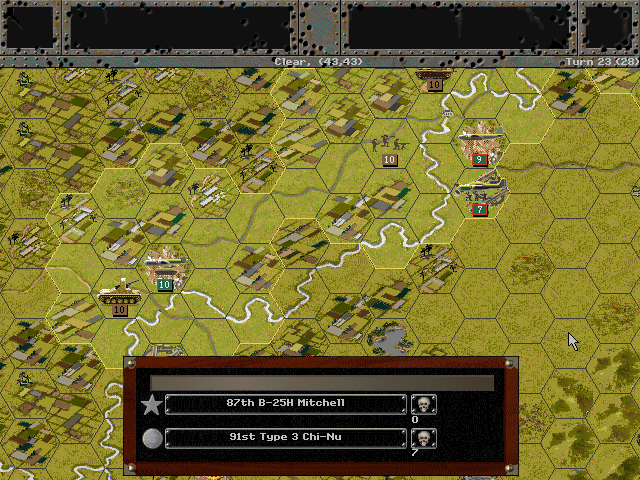
The American bombers return with a vengeance. It seems they've been holding back in order to hit us with a counterattack.
German Turn 22: April 19, 1945
Fair (Dry)

We actually spot the Germans engaging the American planes, which is a heartening sight.
Axis Turn 24: April 19, 1945
Fair (Dry)
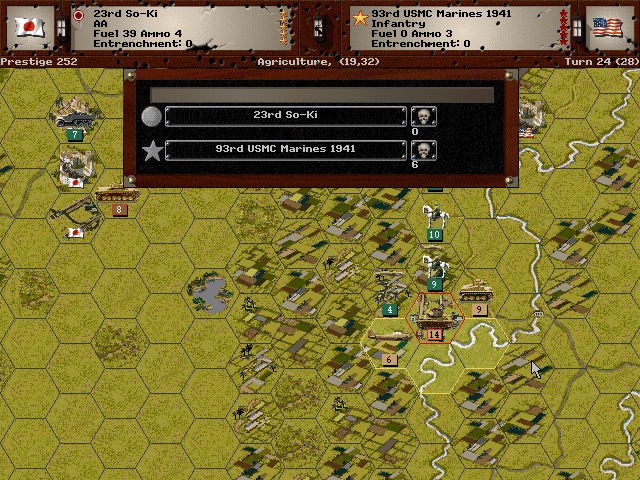
There is a full unit of Marines in Iowa, but they are fresh untrained recruits, and crumple quickly.

We start to put pressure on the remaining American forces as we head into the hills of Kentucky.
Allied Turn 24: April 19, 1945
Fair (Dry)

Surprisingly, one piece of equipment the Iowans do have is the 90mm AA gun. Hirohito's Hieneys get their butts handed to them.
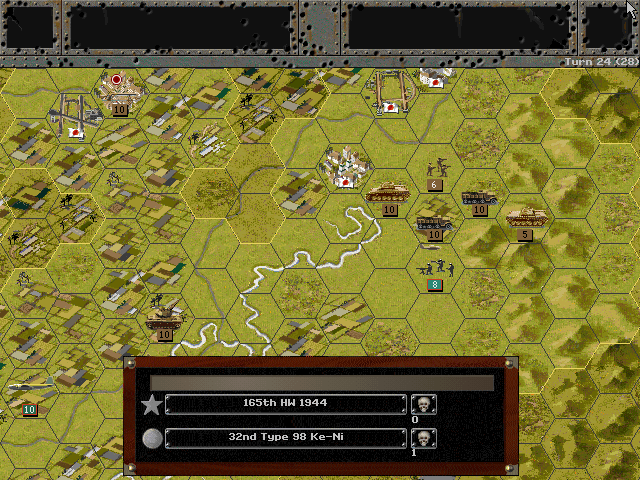
The rough hill country isn't the best place for our tanks, and they are forced to retreat.
Axis Turn 25: April 19, 1945
Fair (Dry)
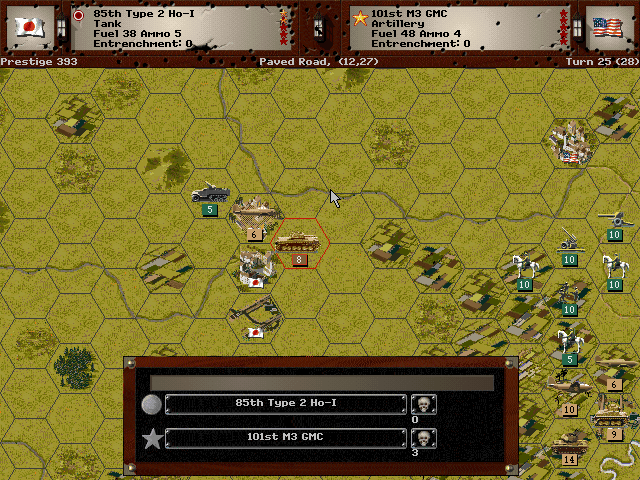
The Iowa forces are not posing a serious threat yet, but they're definitely draining our resources and disrupting our ability to advance.
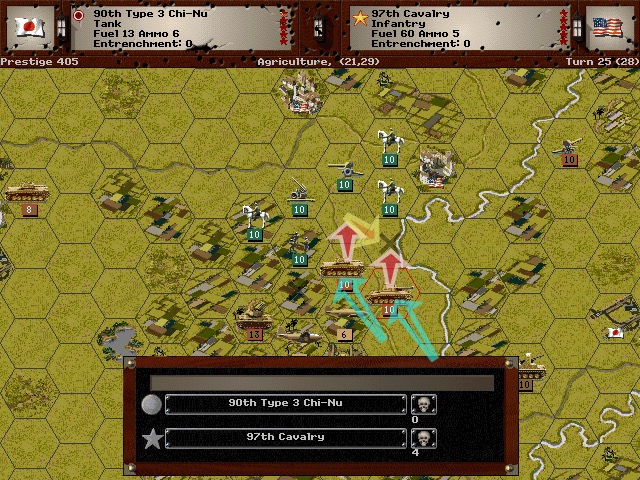
The ragtag rebel forces, mostly crazed civilians on horseback, die or surrender rapidly when the tanks roll in.
Allied Turn 25: April 19, 1945
Fair (Dry)
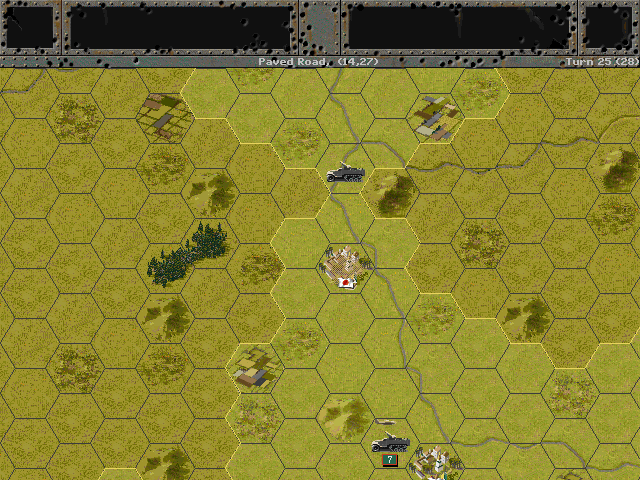
Western Iowa has some military units roaming around, but they don't seem to be gaining much support from the populace.

It's an unlucky day for the Americans in the air, as they fail to land any bombs near our troops, and end up just bombing their own cities.
Axis Turn 26: April 20, 1945
Fair (Dry)

We've now halted the spread of the insurrection, and just need to concentrate on its central headquarters in Davenport.

Well, that and eliminate a few units to the west.
Allied Turn 26: April 20, 1945
Fair (Dry)
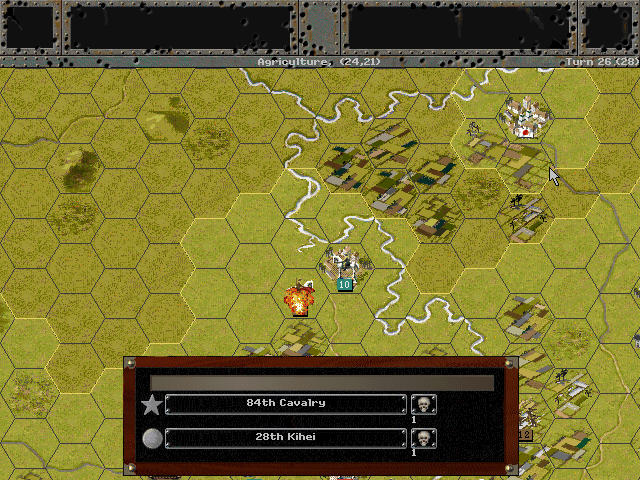
A firefight breaks out near Dubuque between the cavalry units.

The Americans overwhelm us and knock out our scouts.

They have no answer for our armor, however.
German Turn 26: April 20, 1945
Fair (Dry)
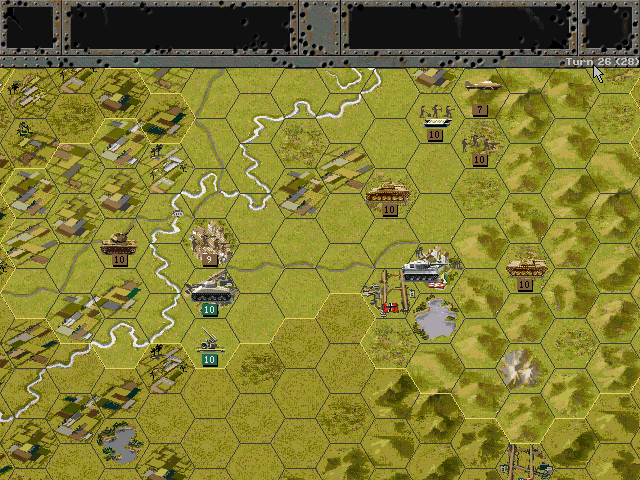
It turns out the Germans are moving up from the south to hit the Americans as well. We have a decision to make here as to how to deal with them.
Axis Turn 27: April 20, 1945
Fair (Dry)
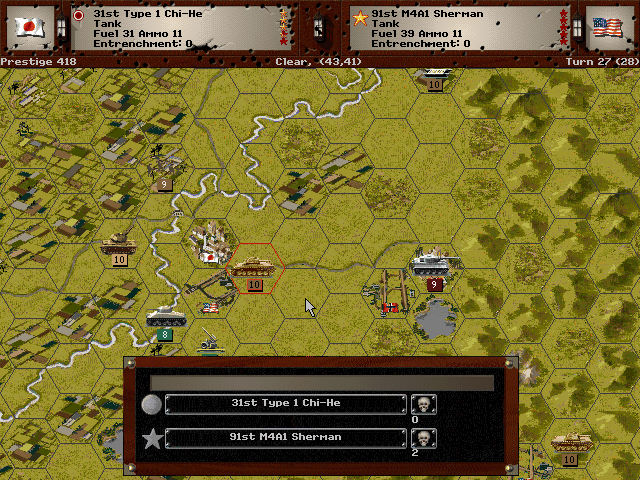
We decide on our plan. We won't attack the Germans directly... but we outflank them in order to do battle with the Americans.
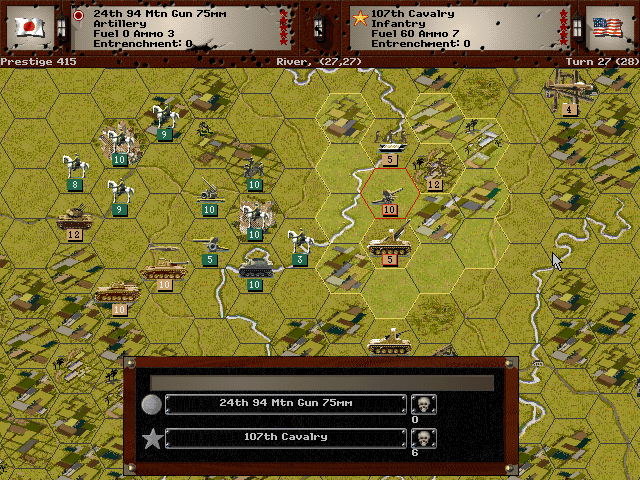
Davenport is turning into a siege, with more insurrectionists arriving from Cedar Rapids.

We've nearly eliminated any units outside of eastern Iowa.
Allied Turn 27: April 20, 1945
Fair (Dry)
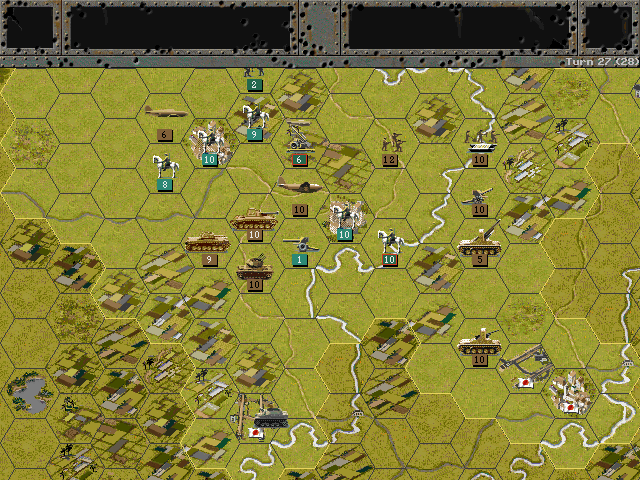
The insurrection appears to be breaking down. Instead of staying to fight, they appear to be trying to make as much mischief as possible.
German Turn 27: April 20, 1945
Fair (Dry)

The Germans react to our maneuver and decide they can play that game too; they send their heavy tanks toward Louisville in what they call a 'support' position for our own forces.
Axis Turn 28: April 20, 1945
Fair (Dry)
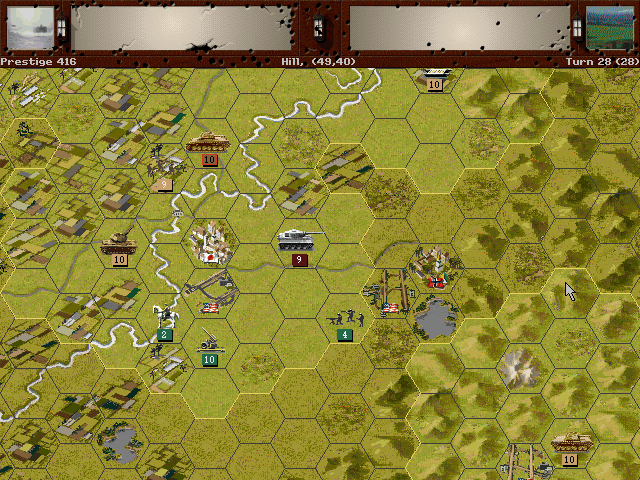
We've decided not to provoke another war. After repelling the American forces, we retreat to the north of the Ohio River, and will pull our other forces out of Kentucky.
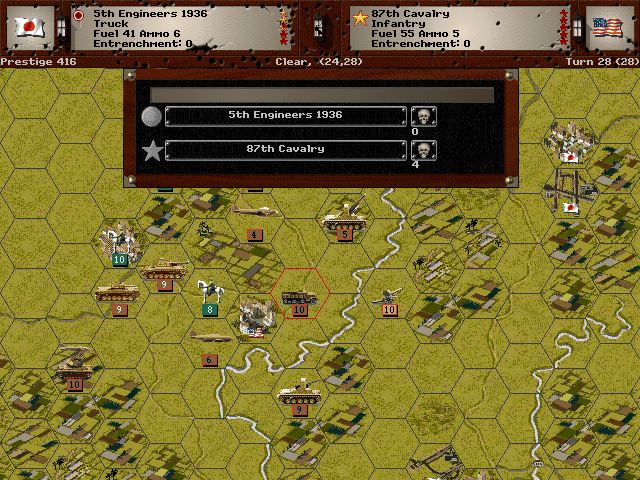
Things are just about wrapped up in Davenport.
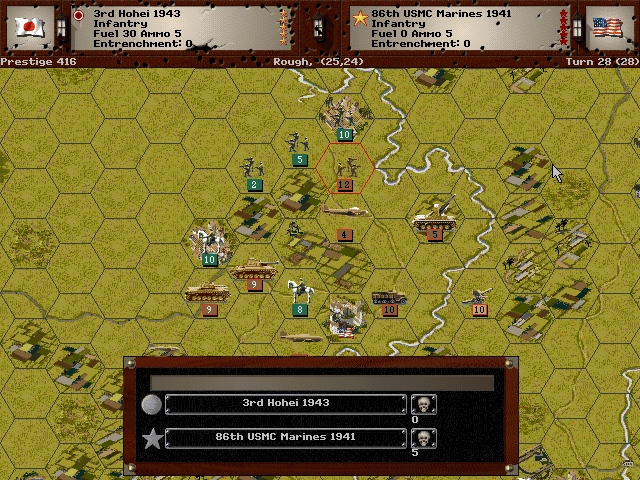
Except just at that moment, we find out that there's a renewed uprising in Dubuque.
Allied Turn 28: April 20, 1945
Fair (Dry)
With their country in ruins, the Americans come to us with their terms of peace.
German Turn 28: April 20, 1945
Fair (Dry)
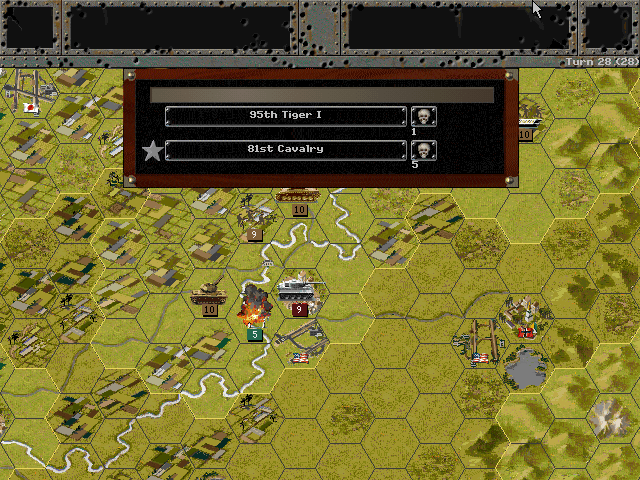
Germany decides to ensure their position; they continue fighting and take Louisville.
The Pacific War is over.

While partisan fighting continues for some time, the Iowans are mostly being suppressed.
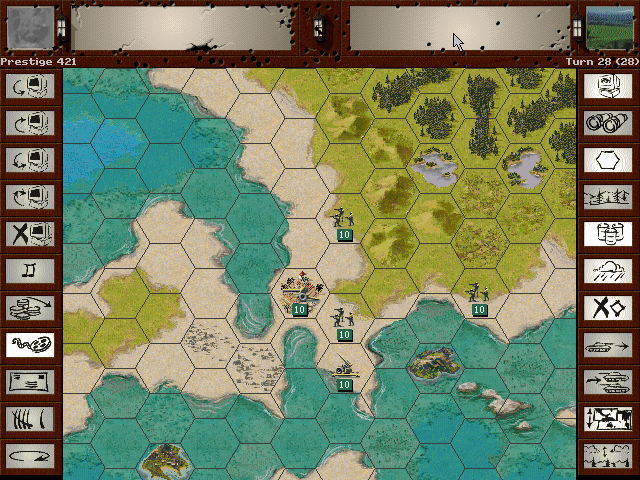
A number of American units have already fled to Canada, where the British government is now residing in exile.

German armies have solid control of the southeastern US, and reports are that they are about to capture Washington.
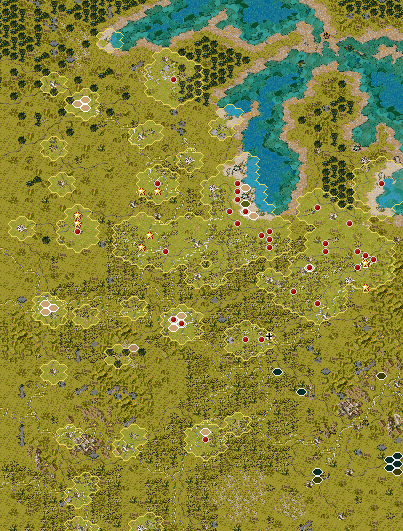

We've managed a complete win.
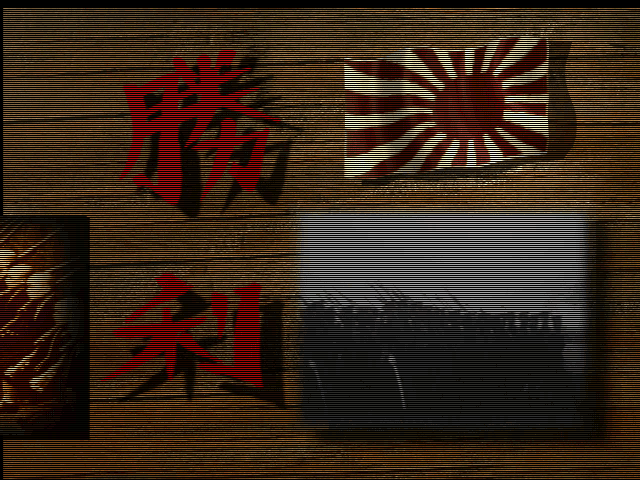
(It says 'victory'.)
Incidentally, we don't actually require a decisive win here, and even a loss is still a decent outcome:

You don't get that 'victory' splash screen, though.
That does it for the Japanese campaign. We'll see just a little bit more from the Japanese side later on, but that'll do it for the core. Hope everyone enjoyed that one; now it's time for the Americans to finish their war.
Unit Spotlight
For the last unit spotlight on this side, we'll finally look at the general infantry available for the Japanese. It's probably too broad a subject to be covered by a single link, but here is a 1943 report on their infantry weapons that the US War Department published. Most regard the Japanese equipment as fairly outmoded, and this only grew worse as the war went on and production and supply problems increased. Assessment of whole nation's infantry is very much a matter of opinion, but I'll give my brief summary of the Japanese army relative to the other belligerents.
At the start of the war at least, Japanese soldiers were rigorously trained and quite formidable despite somewhat poor equipment. A lot of emphasis was placed on training the spirit, and being mentally prepared to either achieve victory or die in battle. The officer corps was not as distinctly class-separated and probably not as broadly-educated as in armies in the European tradition. This may have increased morale with the unit, but the leadership was often somewhat lacking. Although strict obedience to orders was expected (and usually carried out in practice), the infantry were also relied on to fight as individuals and be highly capable in combat. At all levels, the soldiers were very dedicated to the cause and disciplined. To an extent that could also be seen as a detriment, as in practice there was little room for tactical imagination.
Hohei (Infantry)
PG Name: Hohei 1936/1940/1943 Type: Infantry
Effective Date: 1/36 - 1940/ 1/40 - 1943 / 1/43
Value:5/7/9 Cost:72/84/108 Spot:2 Move:3 MM:Leg Trans:Air Fuel: -
Init:1 SA:6/7/7 HA:2/5/8 AA:0 NA:1 GD:6 AD:9 CD:0 TT:Soft Ammo:7
Special: Banzai
In-game analysis: These are rather good stock infantry. While they start out weak against tanks, they overcome that fairly quickly (but then the tanks get tougher more quickly). They're equivalent to the German Wehrmacht Infantry, aside from the Banzai ability. That special means they cost a bit more than their German counterparts, making them a slightly worse deal on the whole. Banzai can be a nice bonus when you need it, but it's really only usable with units you don't expect to live for much longer.
Hohei HW (Infantry)
PG Name: Hohei HW 1936/1940/1943 Type: Infantry
Effective Date: 1/36 - 1940/ 1/40 - 1943 / 1/43
Value:7/8/10 Cost:84/96/120 Spot:2 Move:2 MM:Leg Trans:Air Fuel: -
Init:2 SA:8/8/8 HA:3/5/8 AA:[1] NA:1 GD:8 AD:9 CD:0 TT:Soft Ammo:7
In-game analysis: Probably the biggest advantage these have over the stock infantry unit is their defense. They can hold their ground a lot better than the base Hohei. There isn't quite enough of a distinction to justify the extra cost in an offensively-oriented core, though, since they can't march as quickly.
Engineers
PG Name: Engineers 1936/1943 Type: Infantry
Effective Date: 1/36 - 1943 / 1/43
Value:24/27 Cost:288/324 Spot:2 Move:2 MM:Leg Trans:Air Fuel: -
Init:2 SA:8/9 HA:5/6 AA:[1] NA:1 GD:8/9 AD:9 CD:0 TT:Soft Ammo:7
Special: Engineer, Bunker Killer, Fearless
In-game analysis: The game keeps up the tradition of having Engineers as the best combat unit, although their attack stats aren't quite as high as others. Since even the HW infantry start out with poor AT values, these are the only good infantry to handle hard targets for the early stages of the war. They also receive the least benefit from being upgraded.
Ise-class Battleship (2 built)
PG Name: Ise Type:Battleship
Effective Date: 1/44
Value:26 Cost:468 Spot:2 Move:5 MM:Deep Naval Fuel: 76
Init:5 Range:6 SA:7 HA:10 AA:[10] NA:20 DA:0 GD:20 AD:8 TD:10 Ammo:40
Special: Night Optics, Radar
Like most of the other battleships in the Japanese fleet, the Ise and Hyuga were originally laid down a quarter-century prior to World War II. However, these were given a rather special upgrade after the Battle of Midway. Their rear section was turned into a flight deck, and they became carrier-battleship hybrids. The changes made them not particularly good at either role, however -- they had lost their rear guns in the conversion, and planes could not land on the deck, only launch from it.
In-game analysis: If this were actually a combat-capable carrier, it would at least be kind of interesting, and quite possibly worth it as a ground-attack support unit. As it is, it's just a mediocre battleship. It's not terrible, given the strong Anti-Air power (reflecting launched fighters, perhaps?). Ultimately I find it just a bit too expensive, but if you really need a battleship with more better AA ability, it's not an unreasonable purchase.
Mitsubishi Ki-67 "Hiryu" (Peggy)
PG Name: Ki-67 Flying Dragon Type:Level Bomber
Effective Date: 12/43
Value:42 Cost:504 Spot:2 Move:9 MM:Air Trans:No Fuel: 153
Init:6 SA:1 HA:4 Size: 30 AA:[15] NA:5 GD:14 AD:10 Ammo:6
The Ki-67 was meant to be a heavy bomber with the performance of a fighter plane. While it's hard to say it quite met that measure, it is regarded as one of the best bomber designs produced by the Japanese. It combined good flight performance with a decent level of offensive power and defensive protection. Raw material shortages slowed the production of these for the Army, and ultimately it did not have much of an impact on the battlefield as the tide of the war began to turn against the Japanese.
In-game analysis: When compared with the Emily, this one isn't really a good purchase at all. It has some decent air-to-air ability, but it's not a huge advantage. Ammo capacity is probably of far higher importance to a level bomber, and the bomber should be escorted if there is any enemy presence. This seems like an expensive waste.